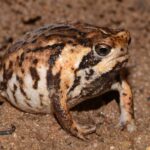The Hidden World of Cardioglossa congolia: Central Africa’s Jewel of the Rainforest#
When we think of frogs, we often envision humid jungles echoing with choruses, lush canopies shading dense undergrowth, and small, distinctive creatures thriving secretly beneath our gaze. Amid the towering rainforests of Central Africa lives precisely such an enigma—the elusive Cardioglossa congolia. Small, intricately patterned, and rarely spotted by casual observers, this rare amphibian embodies the fragility and wonder of biodiversity within its hidden forest sanctuaries.
Cardioglossa congolia, scientifically cataloged only in recent decades, reflects the remarkable diversity and still partly uncharted wilderness in Africa’s equatorial zones. More than a mere curiosity for herpetologists, this beautiful little frog symbolizes the urgent need for nature conservation, reminding us how intimately connected we are with ecological balance. Before we journey deeper into its rainforest habitat, let’s first acquaint ourselves thoroughly with this exceptional amphibian.
Taxonomy and Classification#
The Congolian long-fingered frog, scientifically named Cardioglossa congolia, belongs to the family Arthroleptidae, an intriguing family known for their specialized morphological adaptations and diverse behavioral traits. Within this family, the genus Cardioglossa—whose name translates vividly as “heart-tongue” for the unique shape of its vocal sacs—represents about a dozen closely-related species adapted specially for life in humid Central African forests.
First described by scientists Fritz Nieden and Jean Laurent in 1950, C. congolia has intrigued scientists ever since. It shares its genus with fascinating species such as the beautifully marked Cardioglossa gracilis and Cardioglossa melanogaster, but each displays unique traits tied to distinctive habitats, behaviors, or coloration patterns adapted to niche ecological roles.
Natural Habitat#
Lying deeply embedded within the heart of Central Africa, Cardioglossa congolia has adapted exclusively to lowland and mid-altitude tropical rainforests that stretch across Cameroon, Gabon, the Republic of Congo, and Democratic Republic of the Congo. This region, known biologically as the Congo Basin, harbors an astonishing variety of life adapted to dense, humid ecosystems that are rich in biodiversity yet often challenging, even hostile, for human researchers to penetrate fully.
Beneath lush forest canopies interlaced with vibrant orchids and dense ferns, this frog finds ideal shelter within leaf litter and among fallen logs, hidden from predators or photographers alike. Streams and shaded forest clearings—the forest’s hidden arteries—become critical as the species needs clean freshwater sources for breeding. The humid microclimate of its habitat supports not only its own survival but also an intricate food web of insects that sustain and feed the species.
The Congo Basin’s high rainfall and relatively stable temperatures have enabled this species’ evolution to favor wonderfully specialized adaptations, giving rise to its peculiarly cryptic lifestyle: unseen yet integral.
Physical Characteristics#
Cardioglossa congolia might easily go unnoticed, not just due to its small size—rarely exceeding 3 centimeters—but due to its brilliant camouflage. Its body coloration features warm earth tones, blending chocolate browns and forest greens, interspersed with vivid stripes and patterns that mirror the shadows cast by sun-speckled leaves. With intricate dorsal markings, it embodies natural camouflage perfectly evolved for blending seamlessly with the saturated ground environments it calls home.
Perhaps the most noteworthy adaptation, however, is signified by the elongated fingers, symbolic and literal of its genus name “long-fingered frogs.” These delicate yet purposeful digits help the frog navigate skillfully through leaf debris, moist vegetation, and subtle hiding spots, crucial for both ambushing prey and avoiding becoming prey. Additionally, males exhibit pronounced vocal sacs shaped fascinatingly like tiny heart-shaped structures observed primarily during courtship calls: a mesmerizing physical adaptation synonymous with their genus.
Behavior and Life Cycle#
Understanding Cardioglossa congolia’s obscure behaviors requires patience and dedication. Hymns of its night-song rarely reveal visible performers—only mystical serenades from hidden spots can be heard resonating softly at twilight. Males create melodious calls, luring females to quiet, secluded breeding pools. Courtship in this species appears understated yet vital, usually taking place during the rainy season, when forest streams pool and breeding activity peaks.
Females carefully select hidden crevices, rocky edges, or mossy depressions near running waters for egg deposition. Tiny clusters of delicate, jelly-like eggs are secreted into these moist hideaways, well-protected from harsh environmental extremes yet close to water sources that sustain developing tadpoles.
Upon hatching, the fragile larvae slip silently beneath the water surface, feeding discreetly on microscopic algae, detritus, and aquatic plant material that abound in these freshwater nurseries. Weeks pass, culminating in a stunning metamorphosis. The transformation from underwater-dwelling tadpole to terrestrial, insectivorous adult marks a profound evolutionary process echoed in amphibians worldwide yet uniquely specialized in Cardioglossa congolia.
Ecological Role#
Every creature is an irreplaceable part of its ecosystem’s tapestry, and the Congolian long-fingered frog is no exception. As an insectivorous feeder, it controls populations of small forest insects and, in turn, provides sustenance to larger predators such as small snakes, birds, and mammals. Such connections constitute complex food webs extending from forest floors into towering canopies.
Due to their amphibious life stages, these frogs indicate ecosystem health; their heightened sensitivity makes them exceptional bioindicators. Fragmentation, pollution, or climate stress affecting Cardioglossa populations becomes an early warning system—revealing subtle yet alarming changes in the ecosystem long before human observers might notice.
Threats and Conservation Status#
As immersive observational experiences show, Cardioglossa congolia faces harsh realities. Though currently listed by the IUCN Red List as “Least Concern,” rapid habitat alteration—driven by human activity such as logging, plantations, and mining—constantly threatens its delicate existence. Intact rainforest habitats dwindle under growing pressure, leaving crucial breeding streams and hiding places fragmented and compromised.
Climate change exacerbates these struggles, introducing ecological upheavals like altered rainfall patterns and temperature shifts. Amphibian chytridiomycosis—a fungal disease devastating amphibians globally—further endangers sensitive regional populations.
Yet, conservationists increasingly recognize the stakes. Organisations and initiatives in Central Africa, aiming to protect remnant rainforests and encourage sustainable practices, offer hope. Strengthened understanding helps conservation groups rally local communities to appreciate these tiny forest jewels, thereby fostering regional stewardship of this fascinating frogs’ habitat.
Cultural and Scientific Significance#
Indigenous traditions throughout Central Africa speak often to the subtle symbolism carried by small forest creatures. While Cardioglossa congolia specifically may yet lack explicit cultural documentation—limited by its hidden lifestyle—traditional stories broadly celebrate amphibians symbolizing renewal, transformation, and environmental guardianship closely linked to rain cycles and fertility.
Scientifically, Cardioglossa congolia contributes significantly as a research species enabling herpetologists and conservation biologists to better understand biodiversity processes, forest ecosystem health, and amphibian responses to environmental stressors. The species becomes a crucial piece of a larger investigative plan empowering future generations of biologists to address biodiversity crises.
Conclusion#
Though it remains secretive, quietly trilling and inhabiting shadows, Cardioglossa congolia plays a prominent role in the story of Central Africa’s great rainforests—forests whose resilience is vital to global ecological stability. Appreciating this species means recognizing broader yet delicate connections between ecosystems and humanity’s mutual dependence on these lush habitats.
Let us continue championing conservation, enhancing protection efforts for species like Cardioglossa congolia, so that future nature lovers, students, and researchers may uncover more secrets of these remarkable amphibians still hidden within Earth’s expansive and ever-surprising biodiversity tapestry.










